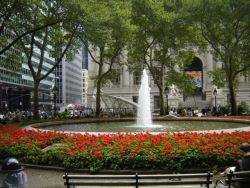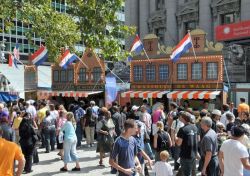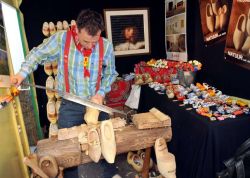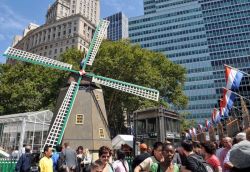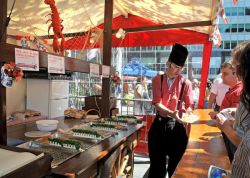Bowling Green
The Daily Plant : Thursday, October 7, 2004
GIVE MY REGARDS TO BROADWAY
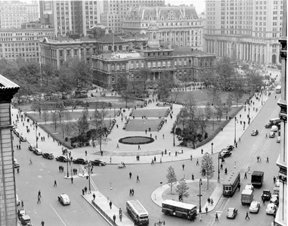
In the grand scheme of things, Broadway means a lot to New York City. From the Battery to the northernmost tip of the island near Inwood Hill Park, Broadway traces its way up, over and through the 13 miles of this skinny little island that constitutes the center of this great city of ours. This article is the first in a series which will outline the various faces of the street that has so many names and so many lives. From the financial section to the theater district to the residential world of the Upper West Side; from the academia of Columbia to the plains of Harlem, to Washington Heights, and all the way to the Cloisters. The same street, Broadway, twists through a dozen microcosms, serving a different function for each.
Broadway appears on the earliest maps of Manhattan. It was the stalk that sprung from a seedling settlement on the southern tip of New Amsterdam. The locus of activity at that time was the Battery, a fortified position with small cannons, that the Dutch settlers built to protect their trading outpost. The area near the Battery became a natural place of congregating; people came there to trade, to socialize, even to recreate. As the City progressed, the Dutch employed their formidable experience in canal building and landfill, and extended the tip of Manhattan further south. A new battery was built on that new land, but the popular public square that evolved next to the original Battery remained. With the defensive component shifted south, all that remained was the social, commercial, and recreational function. And in 1686 that land became New York City’s official public park: Bowling Green.
When Bowling Green became the City’s first park, the City itself still stood almost completely south of Wall Street. This was due to the fact that the wall for which the street is named was still in place. It was built in 1653 when the Dutch and British were at war and New Amsterdam feared an invasion from its northern neighbor, New England. The British, of course, did succeed in taking the land from the Dutch in 1664, and by 1699, development pressure led to the removal of the wall.
During the time the wall stood, the area east of Broadway, west of the Boston Post Road (now Park Row), and south of the collect pond (now Foley Square) was known as the Commons. This public field was meant for the grazing of animals, but buckling under the pressures of development, civic buildings began popping up. In 1736, an almshouse was built on the present site of City Hall. In 1757 a debtor’s prison was built to the east of the almshouse, and later a barracks was built in the approximate location of Tweed Courthouse.
It wasn’t until after the end of the American Revolution and the construction of the present day City Hall, that the thought of designating the Commons as a park came about. When City Hall opened in 1812, some New York citizens said it was too far north of the center of the City. In fact, since City Hall truly did stand at the northern end of the City, the north side of the building was not clad with the same white marble as the front—it was assumed that few people would ever approach it from the north.
But the dawn of the 19th century was a time of great expansion for New York. It was a time when the mercantile cities of the east coast, Philadelphia, New York, Boston, Baltimore, locked in battle to control trade. The city with the best waterway access and infrastructure would reign supreme. By 1807 New York had set in motion what would effectively be the endgame of their master plan, the construction of the Erie Canal and the grid plan for Manhattan. The two worked hand in hand. One brought people and money together, and the other provided a framework for them to grow on, and although more changed about New York than stayed the same, Broadway remained ever-present, a lyrical line through the lattice of Manhattan.
Written by John Mattera
Parks & Recreation Librarian
QUOTATION FOR THE DAY
"True ornament is not a matter of prettifying externals. It is organic with the structure it adorns, whether a person, a building, or a park."
Frank Lloyd Wright
(1867-1959)
Check out your park's Vital Signs
Clean & Safe
Green & Resilient
Empowered & Engaged Users
Share your feedback or learn more about how this park is part of a
Vital Park System

